Assessing the Impact of Liquidity on Australian Banks' Profitability
VerifiedAdded on 2020/05/16
|25
|5518
|80
Report
AI Summary
This research paper examines the impact of liquidity on the profitability of Australian banks. It begins with an executive summary, followed by an introduction that frames the problem statement, research aims, objectives, and questions. The paper then delves into a literature review, exploring liquidity concepts, theories of liquidity management (including Anticipated Income, Shift-ability, Liquidity Management, and Commercial Loan theories), bank profitability concepts, and methods of measurement. The methodology section outlines data collection and analysis processes, followed by data analysis and findings, including descriptive statistics and correlation analyses. The discussion chapter interprets the findings, while the conclusion addresses the research questions, acknowledges limitations, and offers recommendations. The research aims to determine the profitability and liquidity positions of Australian banks and assess the impact of liquidity on their profitability, employing financial ratios and empirical review to support its conclusions.
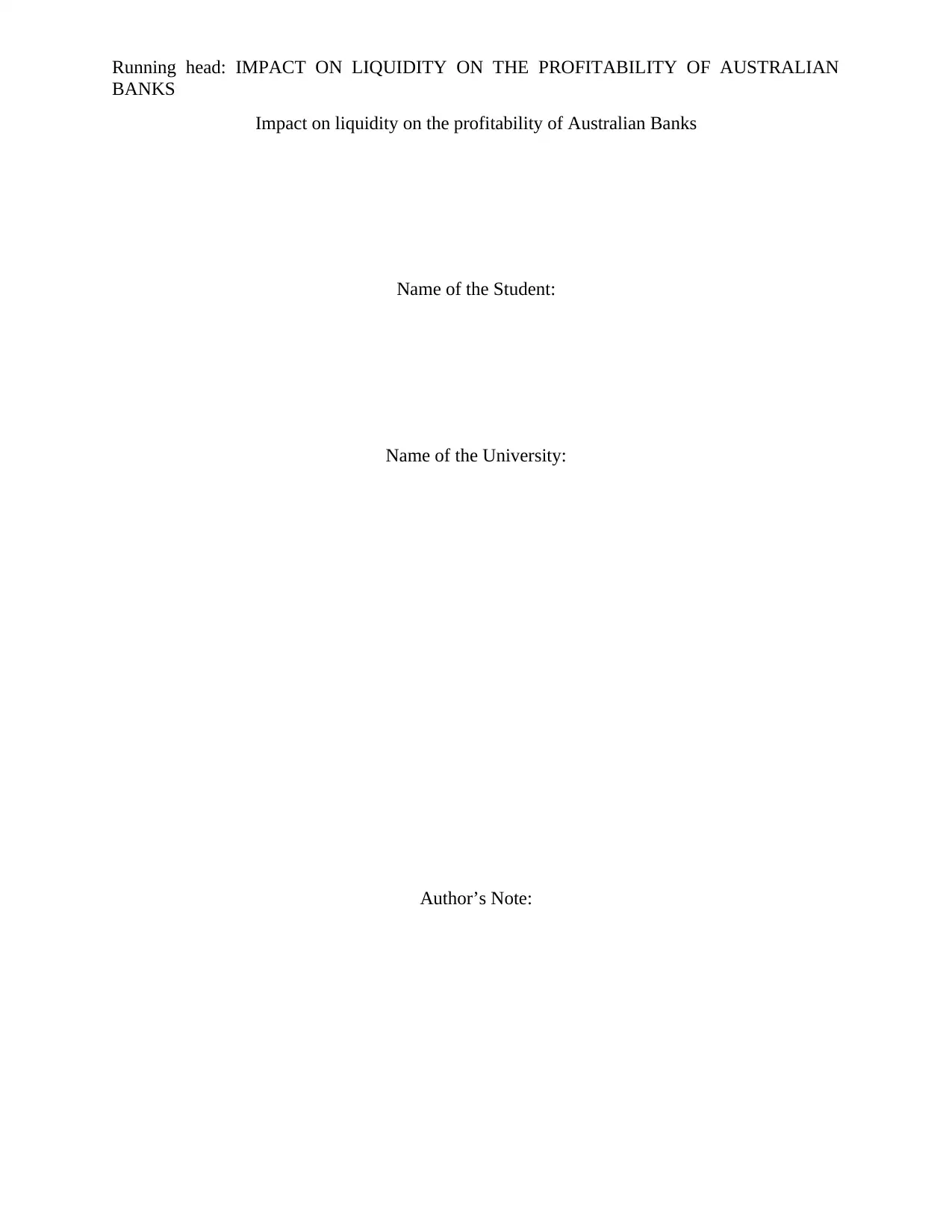
Running head: IMPACT ON LIQUIDITY ON THE PROFITABILITY OF AUSTRALIAN
BANKS
Impact on liquidity on the profitability of Australian Banks
Name of the Student:
Name of the University:
Author’s Note:
BANKS
Impact on liquidity on the profitability of Australian Banks
Name of the Student:
Name of the University:
Author’s Note:
Paraphrase This Document
Need a fresh take? Get an instant paraphrase of this document with our AI Paraphraser
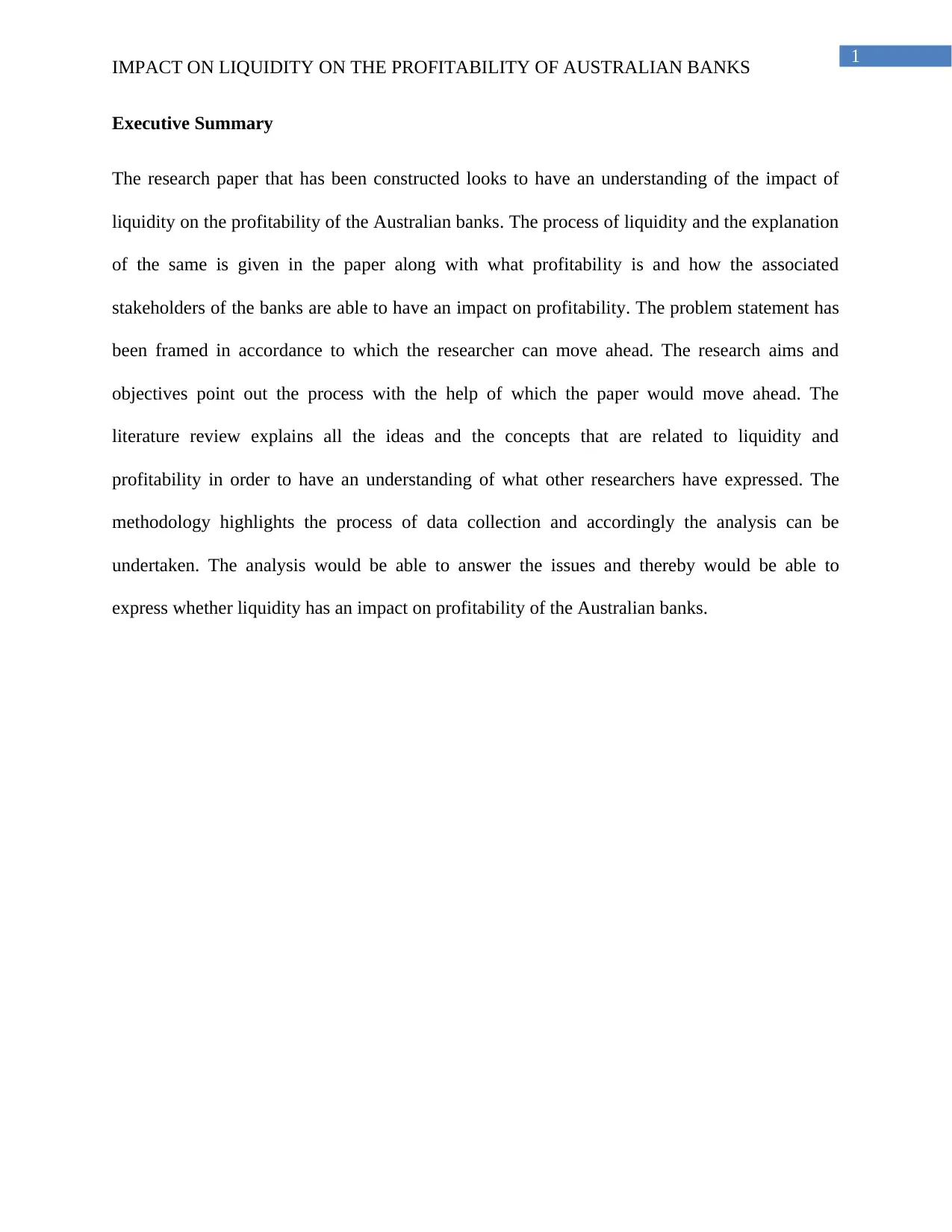
1
IMPACT ON LIQUIDITY ON THE PROFITABILITY OF AUSTRALIAN BANKS
Executive Summary
The research paper that has been constructed looks to have an understanding of the impact of
liquidity on the profitability of the Australian banks. The process of liquidity and the explanation
of the same is given in the paper along with what profitability is and how the associated
stakeholders of the banks are able to have an impact on profitability. The problem statement has
been framed in accordance to which the researcher can move ahead. The research aims and
objectives point out the process with the help of which the paper would move ahead. The
literature review explains all the ideas and the concepts that are related to liquidity and
profitability in order to have an understanding of what other researchers have expressed. The
methodology highlights the process of data collection and accordingly the analysis can be
undertaken. The analysis would be able to answer the issues and thereby would be able to
express whether liquidity has an impact on profitability of the Australian banks.
IMPACT ON LIQUIDITY ON THE PROFITABILITY OF AUSTRALIAN BANKS
Executive Summary
The research paper that has been constructed looks to have an understanding of the impact of
liquidity on the profitability of the Australian banks. The process of liquidity and the explanation
of the same is given in the paper along with what profitability is and how the associated
stakeholders of the banks are able to have an impact on profitability. The problem statement has
been framed in accordance to which the researcher can move ahead. The research aims and
objectives point out the process with the help of which the paper would move ahead. The
literature review explains all the ideas and the concepts that are related to liquidity and
profitability in order to have an understanding of what other researchers have expressed. The
methodology highlights the process of data collection and accordingly the analysis can be
undertaken. The analysis would be able to answer the issues and thereby would be able to
express whether liquidity has an impact on profitability of the Australian banks.
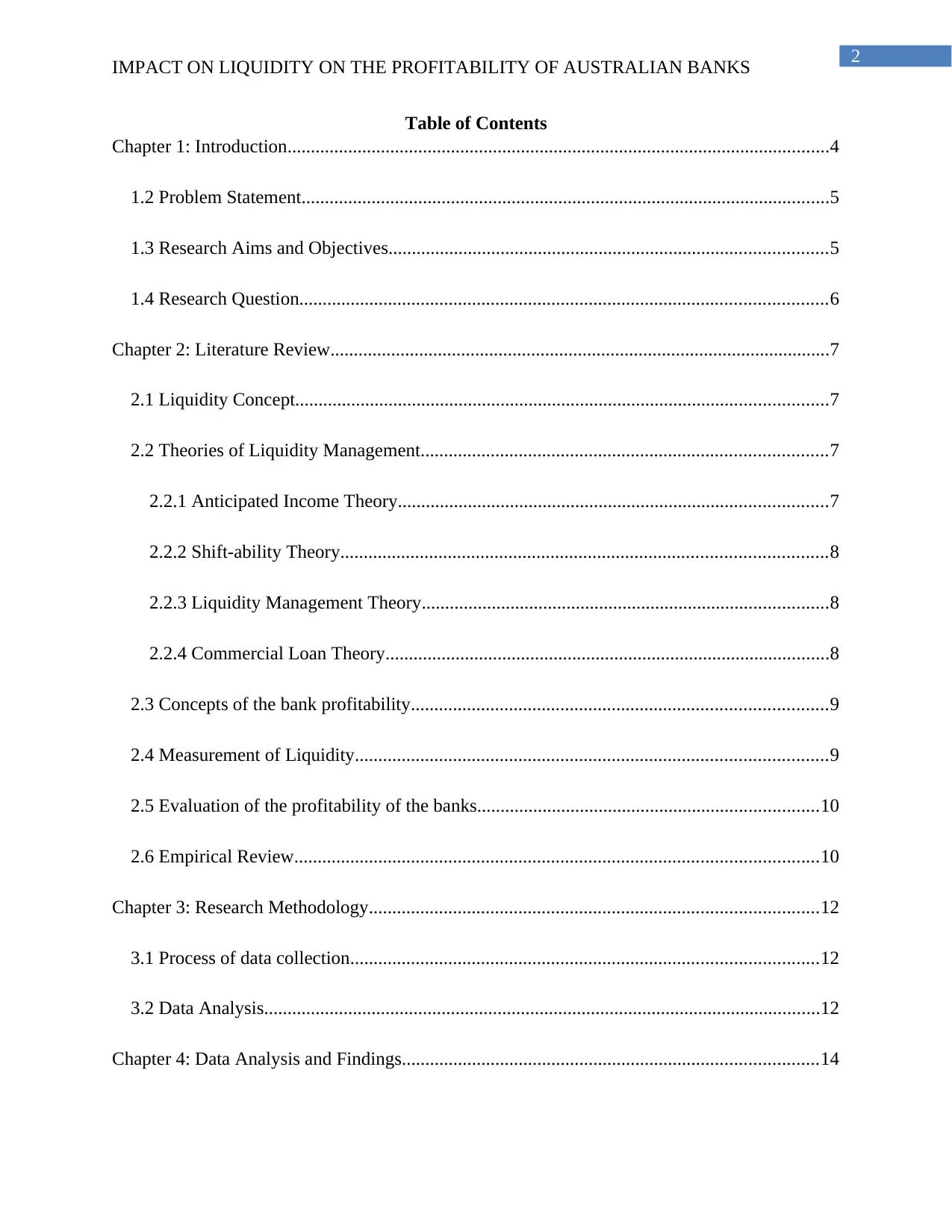
2
IMPACT ON LIQUIDITY ON THE PROFITABILITY OF AUSTRALIAN BANKS
Table of Contents
Chapter 1: Introduction....................................................................................................................4
1.2 Problem Statement.................................................................................................................5
1.3 Research Aims and Objectives..............................................................................................5
1.4 Research Question.................................................................................................................6
Chapter 2: Literature Review...........................................................................................................7
2.1 Liquidity Concept..................................................................................................................7
2.2 Theories of Liquidity Management.......................................................................................7
2.2.1 Anticipated Income Theory............................................................................................7
2.2.2 Shift-ability Theory........................................................................................................8
2.2.3 Liquidity Management Theory.......................................................................................8
2.2.4 Commercial Loan Theory...............................................................................................8
2.3 Concepts of the bank profitability.........................................................................................9
2.4 Measurement of Liquidity.....................................................................................................9
2.5 Evaluation of the profitability of the banks.........................................................................10
2.6 Empirical Review................................................................................................................10
Chapter 3: Research Methodology................................................................................................12
3.1 Process of data collection....................................................................................................12
3.2 Data Analysis.......................................................................................................................12
Chapter 4: Data Analysis and Findings.........................................................................................14
IMPACT ON LIQUIDITY ON THE PROFITABILITY OF AUSTRALIAN BANKS
Table of Contents
Chapter 1: Introduction....................................................................................................................4
1.2 Problem Statement.................................................................................................................5
1.3 Research Aims and Objectives..............................................................................................5
1.4 Research Question.................................................................................................................6
Chapter 2: Literature Review...........................................................................................................7
2.1 Liquidity Concept..................................................................................................................7
2.2 Theories of Liquidity Management.......................................................................................7
2.2.1 Anticipated Income Theory............................................................................................7
2.2.2 Shift-ability Theory........................................................................................................8
2.2.3 Liquidity Management Theory.......................................................................................8
2.2.4 Commercial Loan Theory...............................................................................................8
2.3 Concepts of the bank profitability.........................................................................................9
2.4 Measurement of Liquidity.....................................................................................................9
2.5 Evaluation of the profitability of the banks.........................................................................10
2.6 Empirical Review................................................................................................................10
Chapter 3: Research Methodology................................................................................................12
3.1 Process of data collection....................................................................................................12
3.2 Data Analysis.......................................................................................................................12
Chapter 4: Data Analysis and Findings.........................................................................................14
⊘ This is a preview!⊘
Do you want full access?
Subscribe today to unlock all pages.

Trusted by 1+ million students worldwide
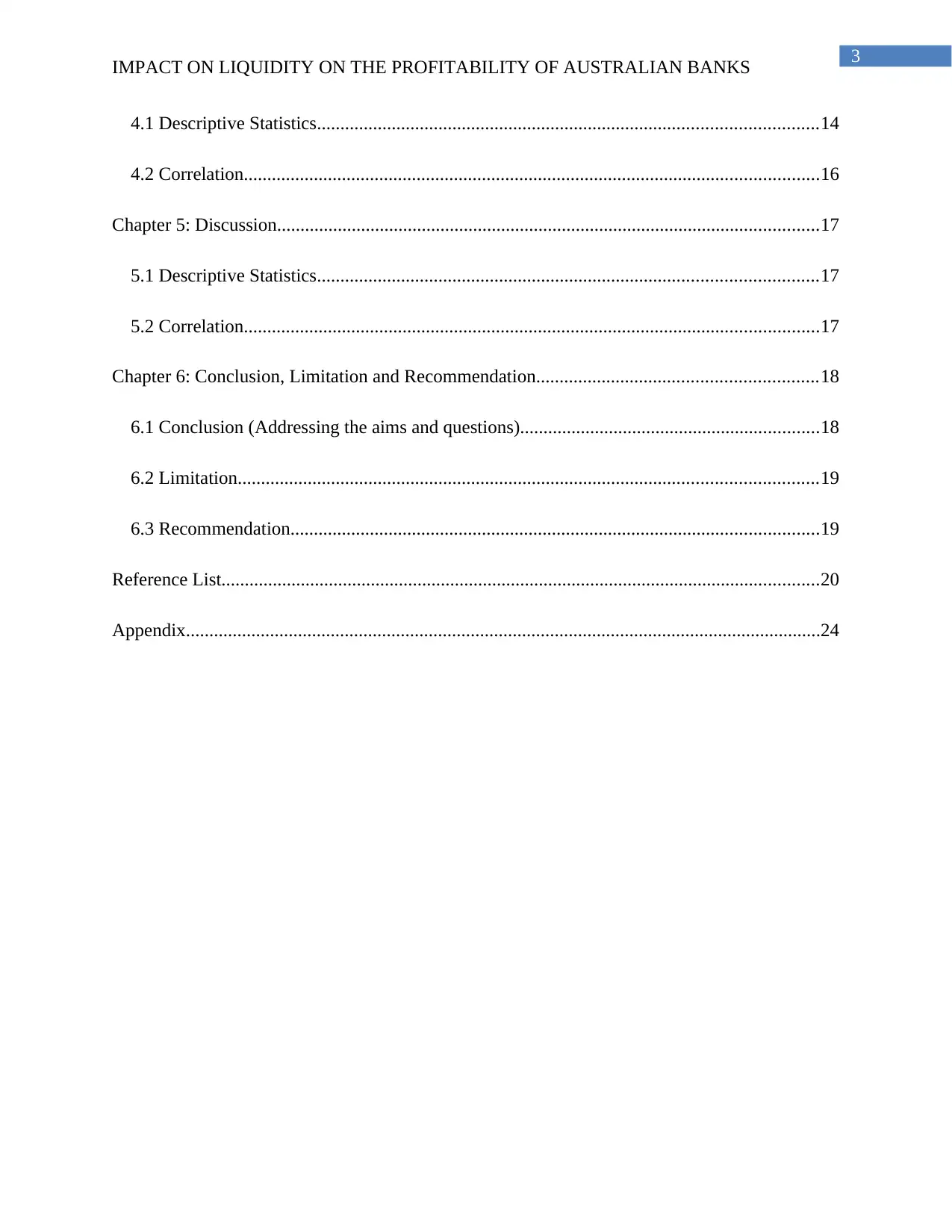
3
IMPACT ON LIQUIDITY ON THE PROFITABILITY OF AUSTRALIAN BANKS
4.1 Descriptive Statistics...........................................................................................................14
4.2 Correlation...........................................................................................................................16
Chapter 5: Discussion....................................................................................................................17
5.1 Descriptive Statistics...........................................................................................................17
5.2 Correlation...........................................................................................................................17
Chapter 6: Conclusion, Limitation and Recommendation............................................................18
6.1 Conclusion (Addressing the aims and questions)................................................................18
6.2 Limitation............................................................................................................................19
6.3 Recommendation.................................................................................................................19
Reference List................................................................................................................................20
Appendix........................................................................................................................................24
IMPACT ON LIQUIDITY ON THE PROFITABILITY OF AUSTRALIAN BANKS
4.1 Descriptive Statistics...........................................................................................................14
4.2 Correlation...........................................................................................................................16
Chapter 5: Discussion....................................................................................................................17
5.1 Descriptive Statistics...........................................................................................................17
5.2 Correlation...........................................................................................................................17
Chapter 6: Conclusion, Limitation and Recommendation............................................................18
6.1 Conclusion (Addressing the aims and questions)................................................................18
6.2 Limitation............................................................................................................................19
6.3 Recommendation.................................................................................................................19
Reference List................................................................................................................................20
Appendix........................................................................................................................................24
Paraphrase This Document
Need a fresh take? Get an instant paraphrase of this document with our AI Paraphraser
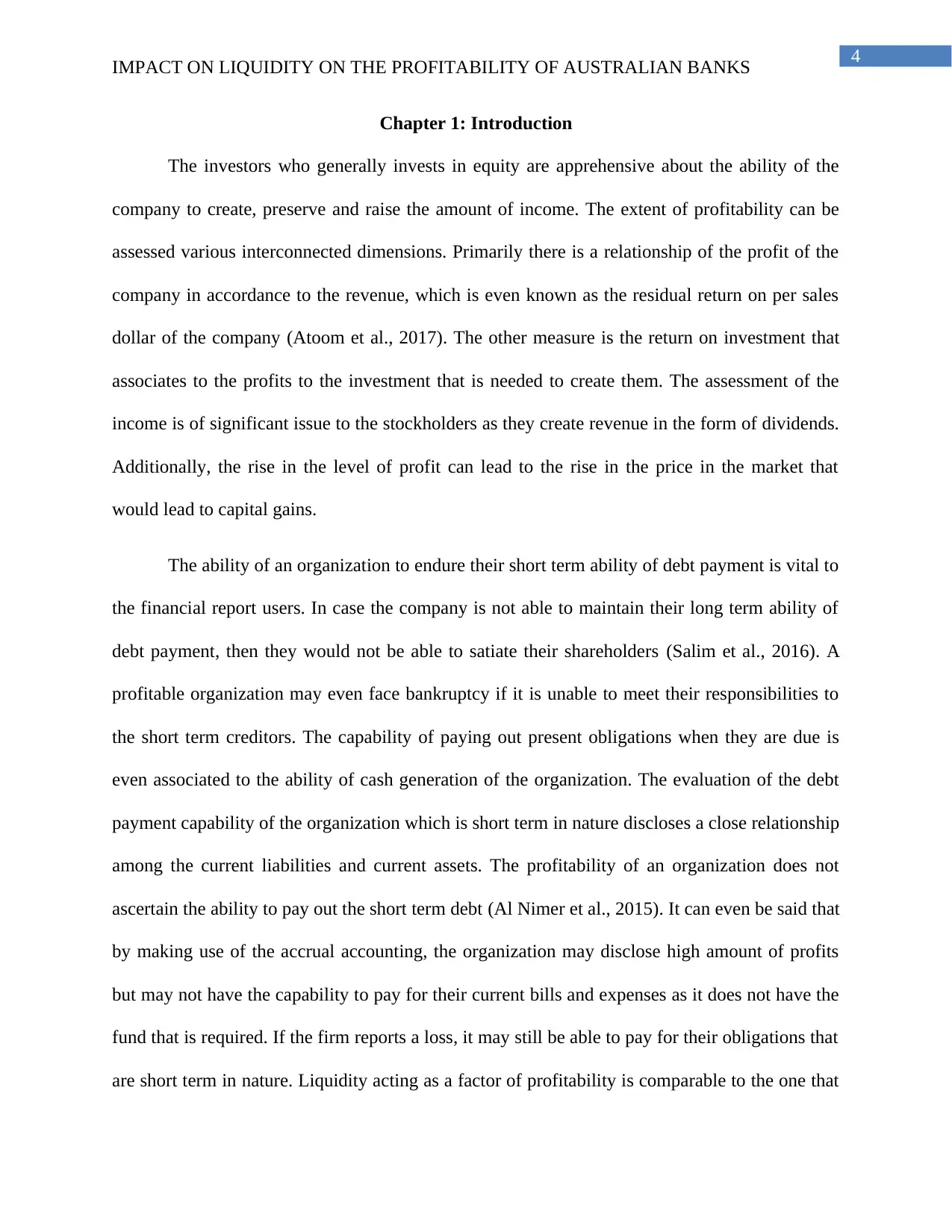
4
IMPACT ON LIQUIDITY ON THE PROFITABILITY OF AUSTRALIAN BANKS
Chapter 1: Introduction
The investors who generally invests in equity are apprehensive about the ability of the
company to create, preserve and raise the amount of income. The extent of profitability can be
assessed various interconnected dimensions. Primarily there is a relationship of the profit of the
company in accordance to the revenue, which is even known as the residual return on per sales
dollar of the company (Atoom et al., 2017). The other measure is the return on investment that
associates to the profits to the investment that is needed to create them. The assessment of the
income is of significant issue to the stockholders as they create revenue in the form of dividends.
Additionally, the rise in the level of profit can lead to the rise in the price in the market that
would lead to capital gains.
The ability of an organization to endure their short term ability of debt payment is vital to
the financial report users. In case the company is not able to maintain their long term ability of
debt payment, then they would not be able to satiate their shareholders (Salim et al., 2016). A
profitable organization may even face bankruptcy if it is unable to meet their responsibilities to
the short term creditors. The capability of paying out present obligations when they are due is
even associated to the ability of cash generation of the organization. The evaluation of the debt
payment capability of the organization which is short term in nature discloses a close relationship
among the current liabilities and current assets. The profitability of an organization does not
ascertain the ability to pay out the short term debt (Al Nimer et al., 2015). It can even be said that
by making use of the accrual accounting, the organization may disclose high amount of profits
but may not have the capability to pay for their current bills and expenses as it does not have the
fund that is required. If the firm reports a loss, it may still be able to pay for their obligations that
are short term in nature. Liquidity acting as a factor of profitability is comparable to the one that
IMPACT ON LIQUIDITY ON THE PROFITABILITY OF AUSTRALIAN BANKS
Chapter 1: Introduction
The investors who generally invests in equity are apprehensive about the ability of the
company to create, preserve and raise the amount of income. The extent of profitability can be
assessed various interconnected dimensions. Primarily there is a relationship of the profit of the
company in accordance to the revenue, which is even known as the residual return on per sales
dollar of the company (Atoom et al., 2017). The other measure is the return on investment that
associates to the profits to the investment that is needed to create them. The assessment of the
income is of significant issue to the stockholders as they create revenue in the form of dividends.
Additionally, the rise in the level of profit can lead to the rise in the price in the market that
would lead to capital gains.
The ability of an organization to endure their short term ability of debt payment is vital to
the financial report users. In case the company is not able to maintain their long term ability of
debt payment, then they would not be able to satiate their shareholders (Salim et al., 2016). A
profitable organization may even face bankruptcy if it is unable to meet their responsibilities to
the short term creditors. The capability of paying out present obligations when they are due is
even associated to the ability of cash generation of the organization. The evaluation of the debt
payment capability of the organization which is short term in nature discloses a close relationship
among the current liabilities and current assets. The profitability of an organization does not
ascertain the ability to pay out the short term debt (Al Nimer et al., 2015). It can even be said that
by making use of the accrual accounting, the organization may disclose high amount of profits
but may not have the capability to pay for their current bills and expenses as it does not have the
fund that is required. If the firm reports a loss, it may still be able to pay for their obligations that
are short term in nature. Liquidity acting as a factor of profitability is comparable to the one that
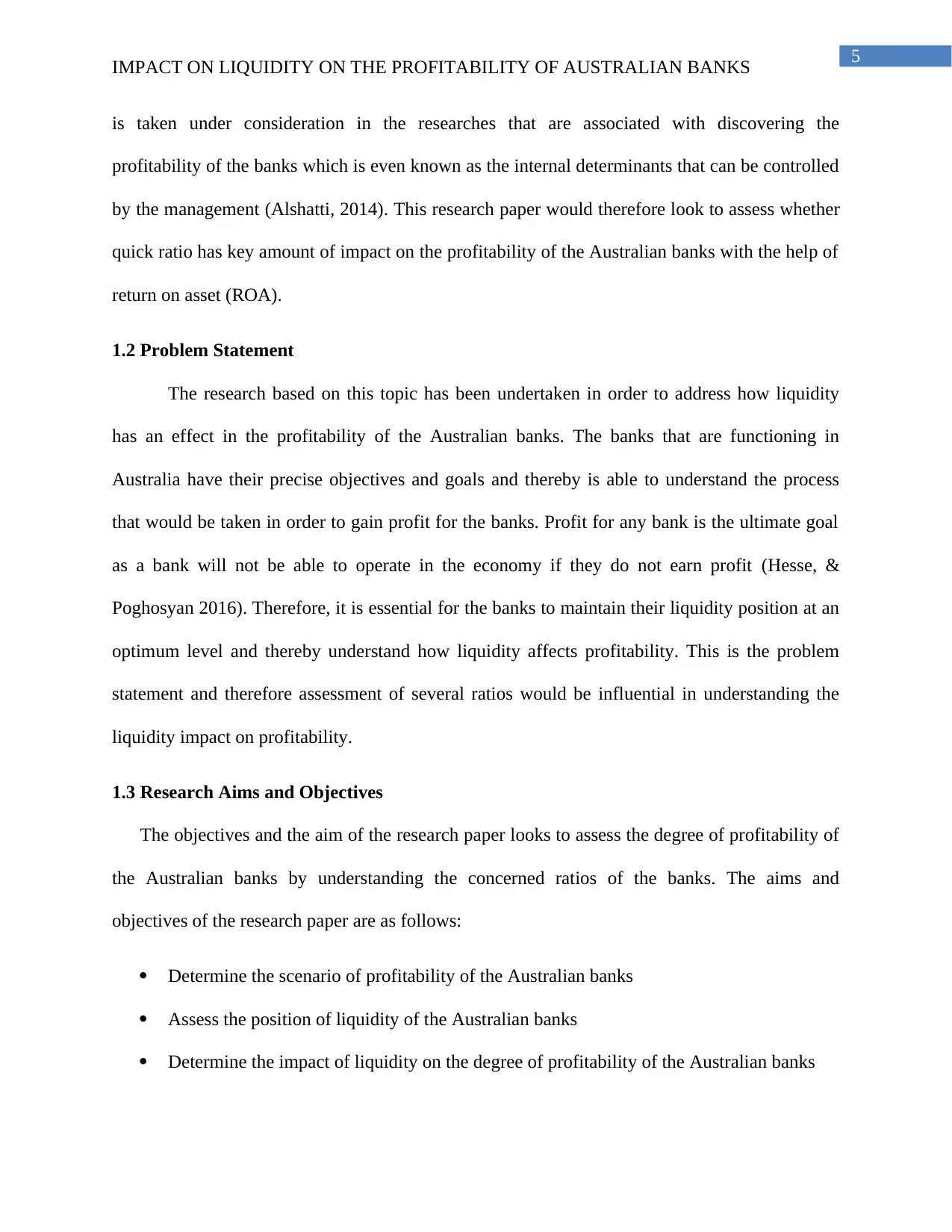
5
IMPACT ON LIQUIDITY ON THE PROFITABILITY OF AUSTRALIAN BANKS
is taken under consideration in the researches that are associated with discovering the
profitability of the banks which is even known as the internal determinants that can be controlled
by the management (Alshatti, 2014). This research paper would therefore look to assess whether
quick ratio has key amount of impact on the profitability of the Australian banks with the help of
return on asset (ROA).
1.2 Problem Statement
The research based on this topic has been undertaken in order to address how liquidity
has an effect in the profitability of the Australian banks. The banks that are functioning in
Australia have their precise objectives and goals and thereby is able to understand the process
that would be taken in order to gain profit for the banks. Profit for any bank is the ultimate goal
as a bank will not be able to operate in the economy if they do not earn profit (Hesse, &
Poghosyan 2016). Therefore, it is essential for the banks to maintain their liquidity position at an
optimum level and thereby understand how liquidity affects profitability. This is the problem
statement and therefore assessment of several ratios would be influential in understanding the
liquidity impact on profitability.
1.3 Research Aims and Objectives
The objectives and the aim of the research paper looks to assess the degree of profitability of
the Australian banks by understanding the concerned ratios of the banks. The aims and
objectives of the research paper are as follows:
Determine the scenario of profitability of the Australian banks
Assess the position of liquidity of the Australian banks
Determine the impact of liquidity on the degree of profitability of the Australian banks
IMPACT ON LIQUIDITY ON THE PROFITABILITY OF AUSTRALIAN BANKS
is taken under consideration in the researches that are associated with discovering the
profitability of the banks which is even known as the internal determinants that can be controlled
by the management (Alshatti, 2014). This research paper would therefore look to assess whether
quick ratio has key amount of impact on the profitability of the Australian banks with the help of
return on asset (ROA).
1.2 Problem Statement
The research based on this topic has been undertaken in order to address how liquidity
has an effect in the profitability of the Australian banks. The banks that are functioning in
Australia have their precise objectives and goals and thereby is able to understand the process
that would be taken in order to gain profit for the banks. Profit for any bank is the ultimate goal
as a bank will not be able to operate in the economy if they do not earn profit (Hesse, &
Poghosyan 2016). Therefore, it is essential for the banks to maintain their liquidity position at an
optimum level and thereby understand how liquidity affects profitability. This is the problem
statement and therefore assessment of several ratios would be influential in understanding the
liquidity impact on profitability.
1.3 Research Aims and Objectives
The objectives and the aim of the research paper looks to assess the degree of profitability of
the Australian banks by understanding the concerned ratios of the banks. The aims and
objectives of the research paper are as follows:
Determine the scenario of profitability of the Australian banks
Assess the position of liquidity of the Australian banks
Determine the impact of liquidity on the degree of profitability of the Australian banks
⊘ This is a preview!⊘
Do you want full access?
Subscribe today to unlock all pages.

Trusted by 1+ million students worldwide
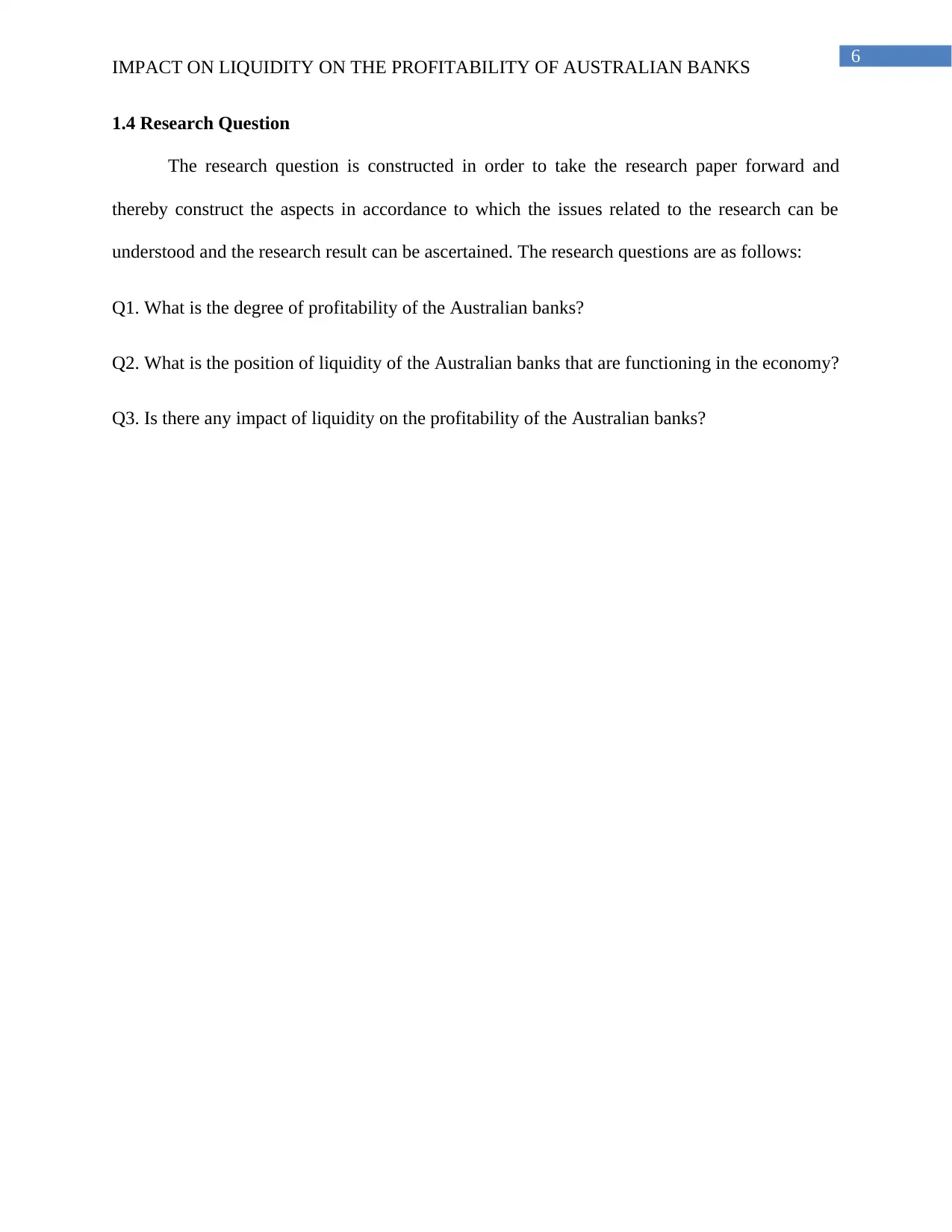
6
IMPACT ON LIQUIDITY ON THE PROFITABILITY OF AUSTRALIAN BANKS
1.4 Research Question
The research question is constructed in order to take the research paper forward and
thereby construct the aspects in accordance to which the issues related to the research can be
understood and the research result can be ascertained. The research questions are as follows:
Q1. What is the degree of profitability of the Australian banks?
Q2. What is the position of liquidity of the Australian banks that are functioning in the economy?
Q3. Is there any impact of liquidity on the profitability of the Australian banks?
IMPACT ON LIQUIDITY ON THE PROFITABILITY OF AUSTRALIAN BANKS
1.4 Research Question
The research question is constructed in order to take the research paper forward and
thereby construct the aspects in accordance to which the issues related to the research can be
understood and the research result can be ascertained. The research questions are as follows:
Q1. What is the degree of profitability of the Australian banks?
Q2. What is the position of liquidity of the Australian banks that are functioning in the economy?
Q3. Is there any impact of liquidity on the profitability of the Australian banks?
Paraphrase This Document
Need a fresh take? Get an instant paraphrase of this document with our AI Paraphraser
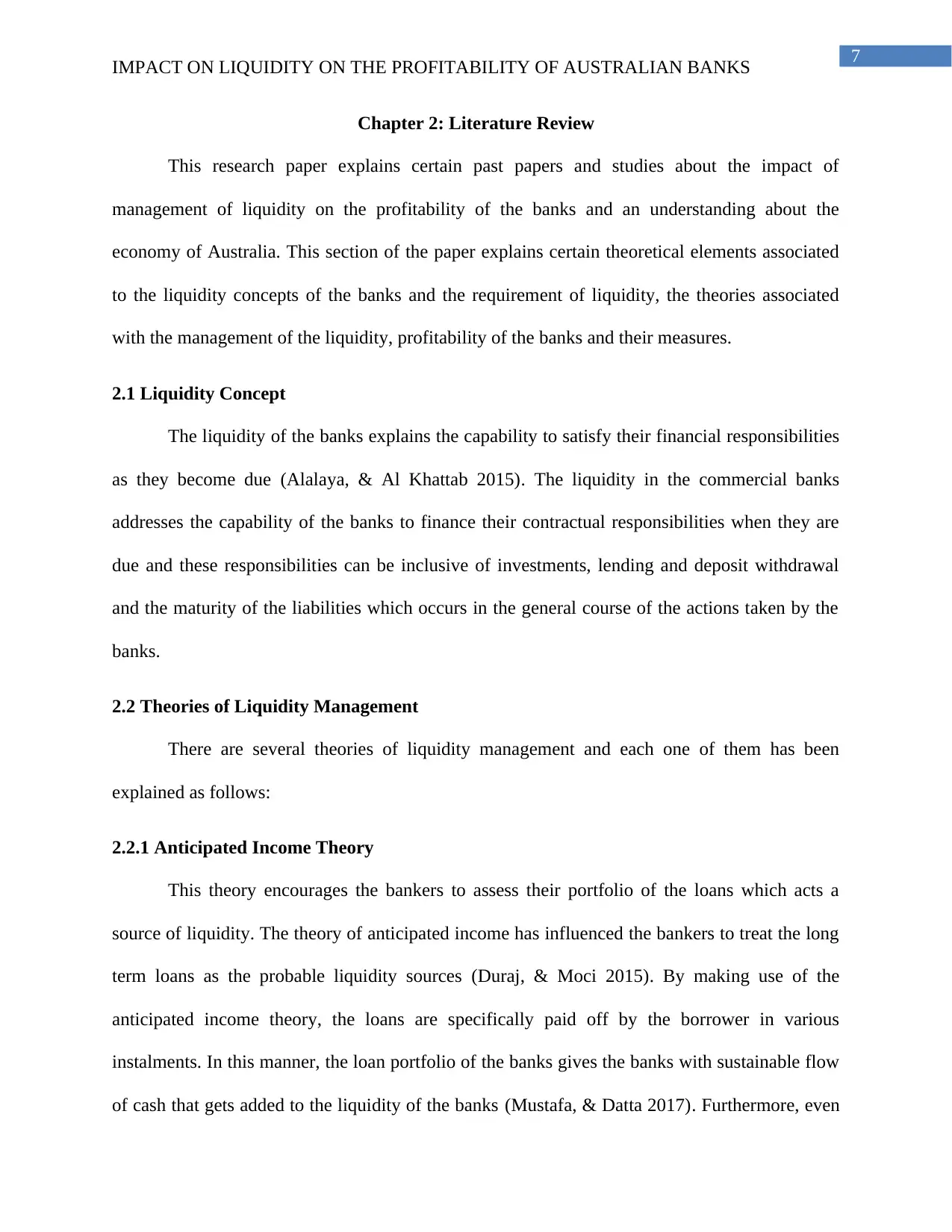
7
IMPACT ON LIQUIDITY ON THE PROFITABILITY OF AUSTRALIAN BANKS
Chapter 2: Literature Review
This research paper explains certain past papers and studies about the impact of
management of liquidity on the profitability of the banks and an understanding about the
economy of Australia. This section of the paper explains certain theoretical elements associated
to the liquidity concepts of the banks and the requirement of liquidity, the theories associated
with the management of the liquidity, profitability of the banks and their measures.
2.1 Liquidity Concept
The liquidity of the banks explains the capability to satisfy their financial responsibilities
as they become due (Alalaya, & Al Khattab 2015). The liquidity in the commercial banks
addresses the capability of the banks to finance their contractual responsibilities when they are
due and these responsibilities can be inclusive of investments, lending and deposit withdrawal
and the maturity of the liabilities which occurs in the general course of the actions taken by the
banks.
2.2 Theories of Liquidity Management
There are several theories of liquidity management and each one of them has been
explained as follows:
2.2.1 Anticipated Income Theory
This theory encourages the bankers to assess their portfolio of the loans which acts a
source of liquidity. The theory of anticipated income has influenced the bankers to treat the long
term loans as the probable liquidity sources (Duraj, & Moci 2015). By making use of the
anticipated income theory, the loans are specifically paid off by the borrower in various
instalments. In this manner, the loan portfolio of the banks gives the banks with sustainable flow
of cash that gets added to the liquidity of the banks (Mustafa, & Datta 2017). Furthermore, even
IMPACT ON LIQUIDITY ON THE PROFITABILITY OF AUSTRALIAN BANKS
Chapter 2: Literature Review
This research paper explains certain past papers and studies about the impact of
management of liquidity on the profitability of the banks and an understanding about the
economy of Australia. This section of the paper explains certain theoretical elements associated
to the liquidity concepts of the banks and the requirement of liquidity, the theories associated
with the management of the liquidity, profitability of the banks and their measures.
2.1 Liquidity Concept
The liquidity of the banks explains the capability to satisfy their financial responsibilities
as they become due (Alalaya, & Al Khattab 2015). The liquidity in the commercial banks
addresses the capability of the banks to finance their contractual responsibilities when they are
due and these responsibilities can be inclusive of investments, lending and deposit withdrawal
and the maturity of the liabilities which occurs in the general course of the actions taken by the
banks.
2.2 Theories of Liquidity Management
There are several theories of liquidity management and each one of them has been
explained as follows:
2.2.1 Anticipated Income Theory
This theory encourages the bankers to assess their portfolio of the loans which acts a
source of liquidity. The theory of anticipated income has influenced the bankers to treat the long
term loans as the probable liquidity sources (Duraj, & Moci 2015). By making use of the
anticipated income theory, the loans are specifically paid off by the borrower in various
instalments. In this manner, the loan portfolio of the banks gives the banks with sustainable flow
of cash that gets added to the liquidity of the banks (Mustafa, & Datta 2017). Furthermore, even
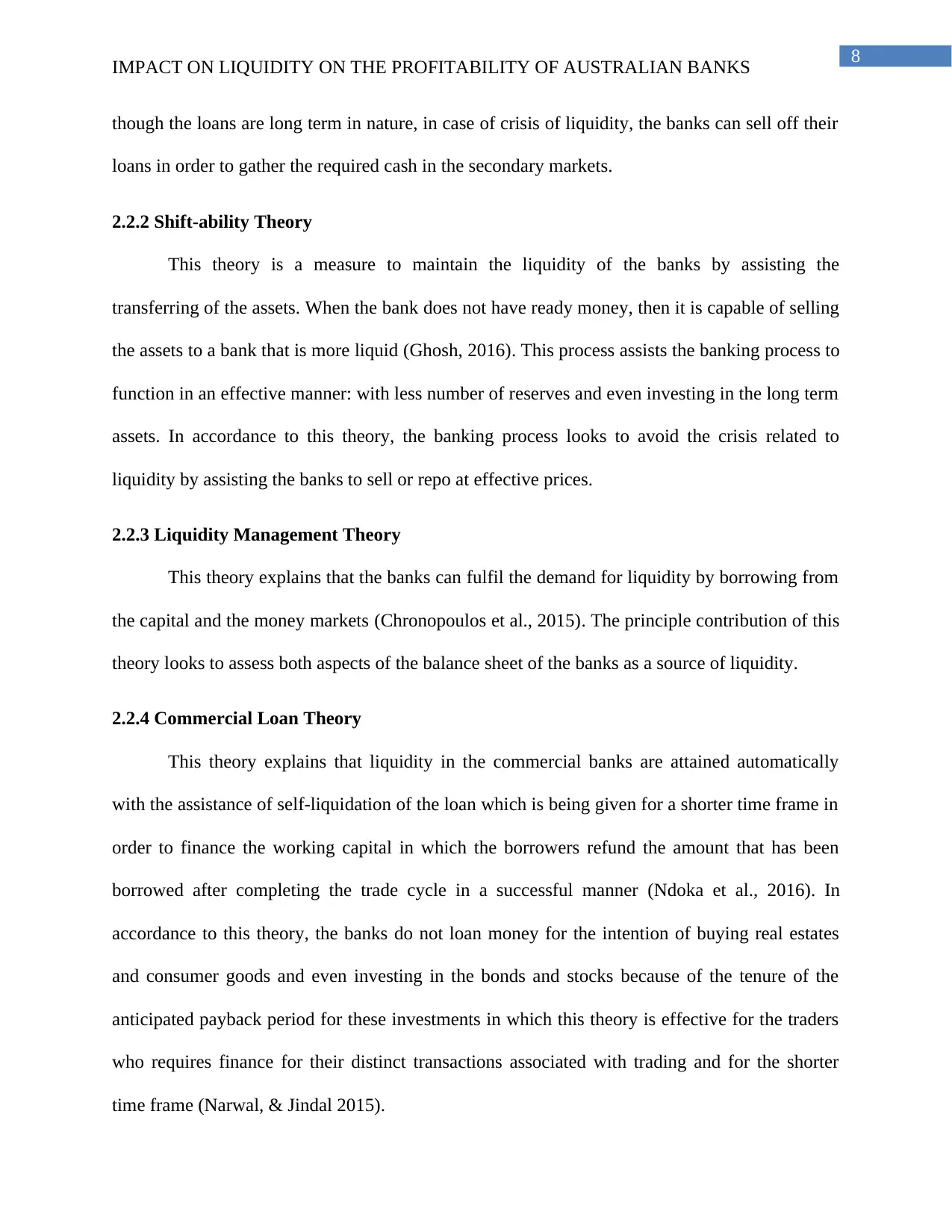
8
IMPACT ON LIQUIDITY ON THE PROFITABILITY OF AUSTRALIAN BANKS
though the loans are long term in nature, in case of crisis of liquidity, the banks can sell off their
loans in order to gather the required cash in the secondary markets.
2.2.2 Shift-ability Theory
This theory is a measure to maintain the liquidity of the banks by assisting the
transferring of the assets. When the bank does not have ready money, then it is capable of selling
the assets to a bank that is more liquid (Ghosh, 2016). This process assists the banking process to
function in an effective manner: with less number of reserves and even investing in the long term
assets. In accordance to this theory, the banking process looks to avoid the crisis related to
liquidity by assisting the banks to sell or repo at effective prices.
2.2.3 Liquidity Management Theory
This theory explains that the banks can fulfil the demand for liquidity by borrowing from
the capital and the money markets (Chronopoulos et al., 2015). The principle contribution of this
theory looks to assess both aspects of the balance sheet of the banks as a source of liquidity.
2.2.4 Commercial Loan Theory
This theory explains that liquidity in the commercial banks are attained automatically
with the assistance of self-liquidation of the loan which is being given for a shorter time frame in
order to finance the working capital in which the borrowers refund the amount that has been
borrowed after completing the trade cycle in a successful manner (Ndoka et al., 2016). In
accordance to this theory, the banks do not loan money for the intention of buying real estates
and consumer goods and even investing in the bonds and stocks because of the tenure of the
anticipated payback period for these investments in which this theory is effective for the traders
who requires finance for their distinct transactions associated with trading and for the shorter
time frame (Narwal, & Jindal 2015).
IMPACT ON LIQUIDITY ON THE PROFITABILITY OF AUSTRALIAN BANKS
though the loans are long term in nature, in case of crisis of liquidity, the banks can sell off their
loans in order to gather the required cash in the secondary markets.
2.2.2 Shift-ability Theory
This theory is a measure to maintain the liquidity of the banks by assisting the
transferring of the assets. When the bank does not have ready money, then it is capable of selling
the assets to a bank that is more liquid (Ghosh, 2016). This process assists the banking process to
function in an effective manner: with less number of reserves and even investing in the long term
assets. In accordance to this theory, the banking process looks to avoid the crisis related to
liquidity by assisting the banks to sell or repo at effective prices.
2.2.3 Liquidity Management Theory
This theory explains that the banks can fulfil the demand for liquidity by borrowing from
the capital and the money markets (Chronopoulos et al., 2015). The principle contribution of this
theory looks to assess both aspects of the balance sheet of the banks as a source of liquidity.
2.2.4 Commercial Loan Theory
This theory explains that liquidity in the commercial banks are attained automatically
with the assistance of self-liquidation of the loan which is being given for a shorter time frame in
order to finance the working capital in which the borrowers refund the amount that has been
borrowed after completing the trade cycle in a successful manner (Ndoka et al., 2016). In
accordance to this theory, the banks do not loan money for the intention of buying real estates
and consumer goods and even investing in the bonds and stocks because of the tenure of the
anticipated payback period for these investments in which this theory is effective for the traders
who requires finance for their distinct transactions associated with trading and for the shorter
time frame (Narwal, & Jindal 2015).
⊘ This is a preview!⊘
Do you want full access?
Subscribe today to unlock all pages.

Trusted by 1+ million students worldwide
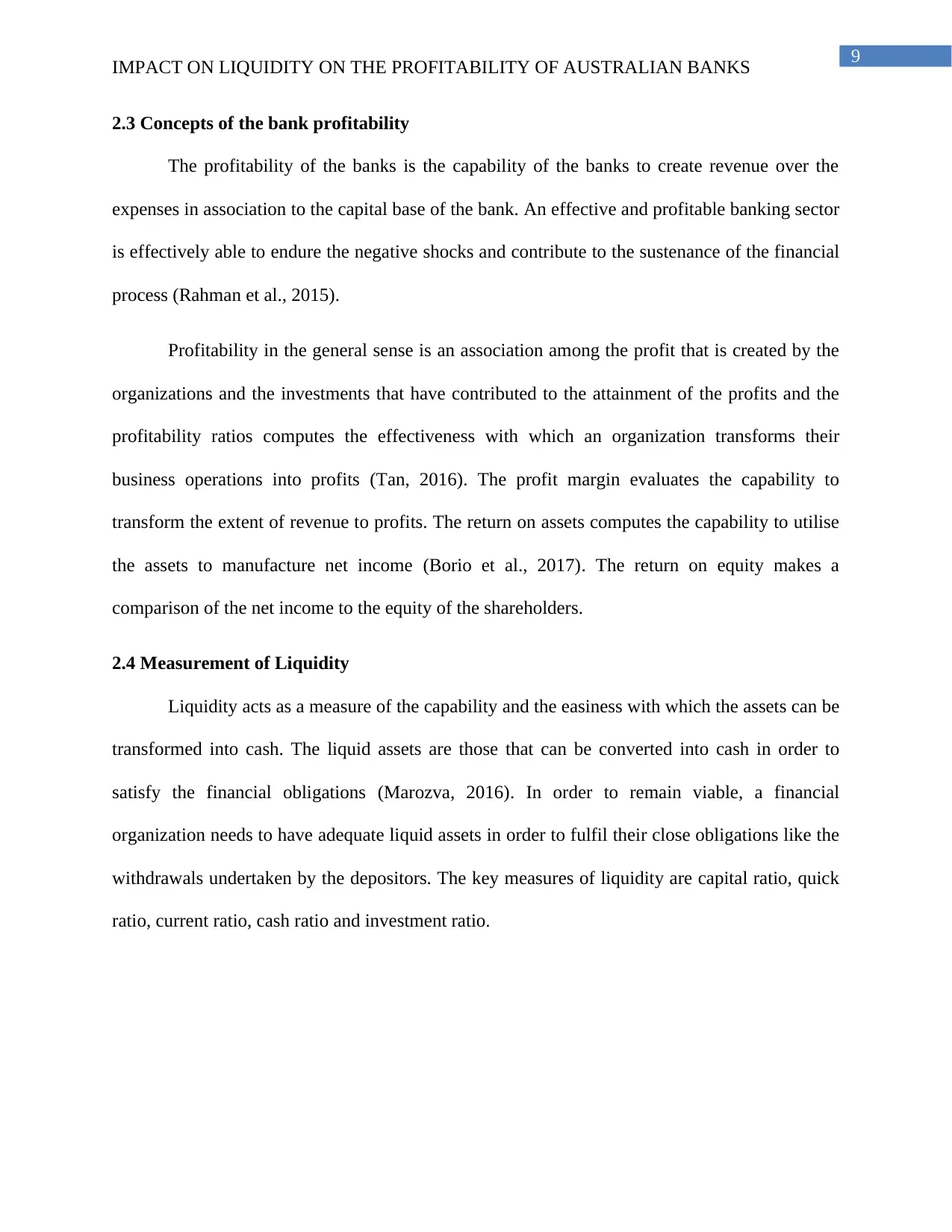
9
IMPACT ON LIQUIDITY ON THE PROFITABILITY OF AUSTRALIAN BANKS
2.3 Concepts of the bank profitability
The profitability of the banks is the capability of the banks to create revenue over the
expenses in association to the capital base of the bank. An effective and profitable banking sector
is effectively able to endure the negative shocks and contribute to the sustenance of the financial
process (Rahman et al., 2015).
Profitability in the general sense is an association among the profit that is created by the
organizations and the investments that have contributed to the attainment of the profits and the
profitability ratios computes the effectiveness with which an organization transforms their
business operations into profits (Tan, 2016). The profit margin evaluates the capability to
transform the extent of revenue to profits. The return on assets computes the capability to utilise
the assets to manufacture net income (Borio et al., 2017). The return on equity makes a
comparison of the net income to the equity of the shareholders.
2.4 Measurement of Liquidity
Liquidity acts as a measure of the capability and the easiness with which the assets can be
transformed into cash. The liquid assets are those that can be converted into cash in order to
satisfy the financial obligations (Marozva, 2016). In order to remain viable, a financial
organization needs to have adequate liquid assets in order to fulfil their close obligations like the
withdrawals undertaken by the depositors. The key measures of liquidity are capital ratio, quick
ratio, current ratio, cash ratio and investment ratio.
IMPACT ON LIQUIDITY ON THE PROFITABILITY OF AUSTRALIAN BANKS
2.3 Concepts of the bank profitability
The profitability of the banks is the capability of the banks to create revenue over the
expenses in association to the capital base of the bank. An effective and profitable banking sector
is effectively able to endure the negative shocks and contribute to the sustenance of the financial
process (Rahman et al., 2015).
Profitability in the general sense is an association among the profit that is created by the
organizations and the investments that have contributed to the attainment of the profits and the
profitability ratios computes the effectiveness with which an organization transforms their
business operations into profits (Tan, 2016). The profit margin evaluates the capability to
transform the extent of revenue to profits. The return on assets computes the capability to utilise
the assets to manufacture net income (Borio et al., 2017). The return on equity makes a
comparison of the net income to the equity of the shareholders.
2.4 Measurement of Liquidity
Liquidity acts as a measure of the capability and the easiness with which the assets can be
transformed into cash. The liquid assets are those that can be converted into cash in order to
satisfy the financial obligations (Marozva, 2016). In order to remain viable, a financial
organization needs to have adequate liquid assets in order to fulfil their close obligations like the
withdrawals undertaken by the depositors. The key measures of liquidity are capital ratio, quick
ratio, current ratio, cash ratio and investment ratio.
Paraphrase This Document
Need a fresh take? Get an instant paraphrase of this document with our AI Paraphraser
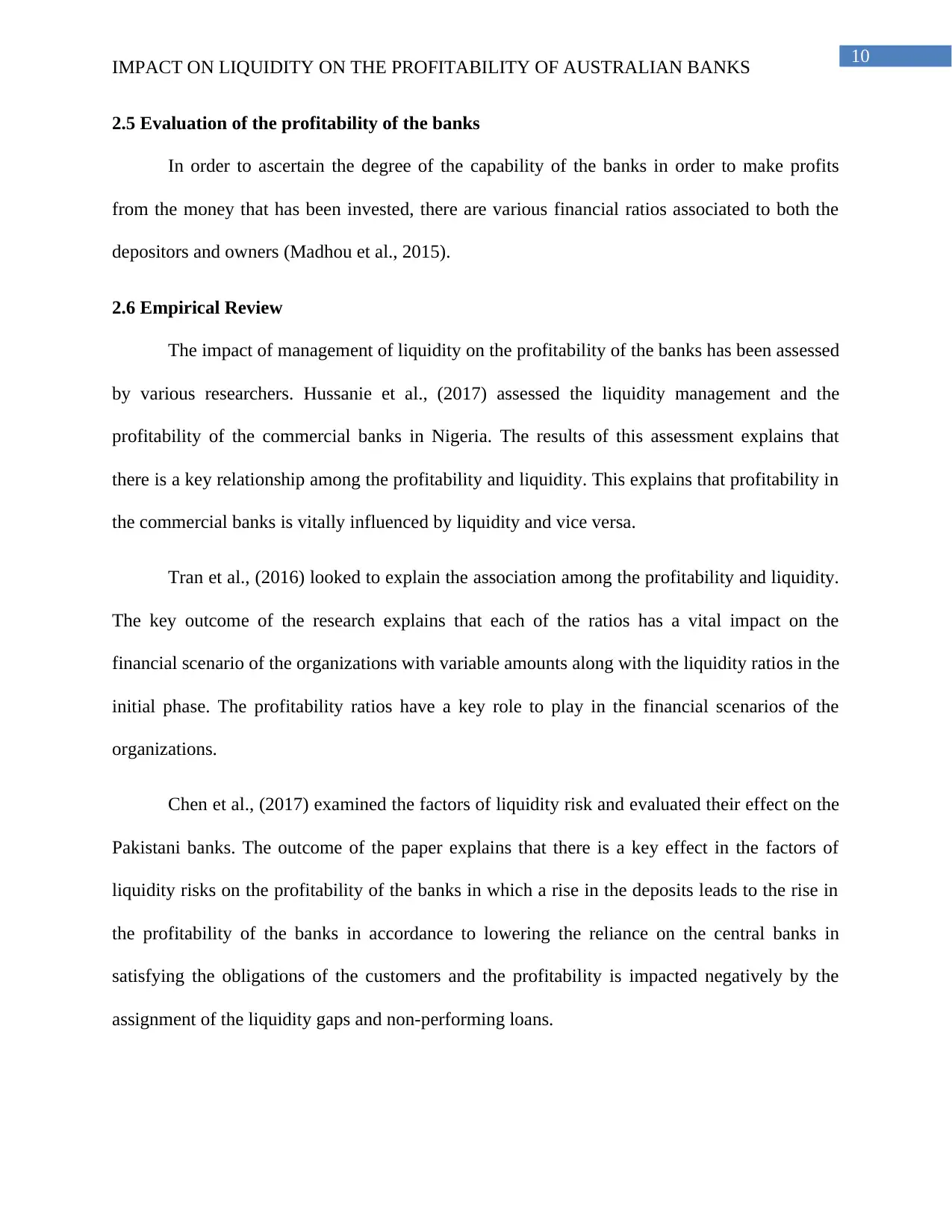
10
IMPACT ON LIQUIDITY ON THE PROFITABILITY OF AUSTRALIAN BANKS
2.5 Evaluation of the profitability of the banks
In order to ascertain the degree of the capability of the banks in order to make profits
from the money that has been invested, there are various financial ratios associated to both the
depositors and owners (Madhou et al., 2015).
2.6 Empirical Review
The impact of management of liquidity on the profitability of the banks has been assessed
by various researchers. Hussanie et al., (2017) assessed the liquidity management and the
profitability of the commercial banks in Nigeria. The results of this assessment explains that
there is a key relationship among the profitability and liquidity. This explains that profitability in
the commercial banks is vitally influenced by liquidity and vice versa.
Tran et al., (2016) looked to explain the association among the profitability and liquidity.
The key outcome of the research explains that each of the ratios has a vital impact on the
financial scenario of the organizations with variable amounts along with the liquidity ratios in the
initial phase. The profitability ratios have a key role to play in the financial scenarios of the
organizations.
Chen et al., (2017) examined the factors of liquidity risk and evaluated their effect on the
Pakistani banks. The outcome of the paper explains that there is a key effect in the factors of
liquidity risks on the profitability of the banks in which a rise in the deposits leads to the rise in
the profitability of the banks in accordance to lowering the reliance on the central banks in
satisfying the obligations of the customers and the profitability is impacted negatively by the
assignment of the liquidity gaps and non-performing loans.
IMPACT ON LIQUIDITY ON THE PROFITABILITY OF AUSTRALIAN BANKS
2.5 Evaluation of the profitability of the banks
In order to ascertain the degree of the capability of the banks in order to make profits
from the money that has been invested, there are various financial ratios associated to both the
depositors and owners (Madhou et al., 2015).
2.6 Empirical Review
The impact of management of liquidity on the profitability of the banks has been assessed
by various researchers. Hussanie et al., (2017) assessed the liquidity management and the
profitability of the commercial banks in Nigeria. The results of this assessment explains that
there is a key relationship among the profitability and liquidity. This explains that profitability in
the commercial banks is vitally influenced by liquidity and vice versa.
Tran et al., (2016) looked to explain the association among the profitability and liquidity.
The key outcome of the research explains that each of the ratios has a vital impact on the
financial scenario of the organizations with variable amounts along with the liquidity ratios in the
initial phase. The profitability ratios have a key role to play in the financial scenarios of the
organizations.
Chen et al., (2017) examined the factors of liquidity risk and evaluated their effect on the
Pakistani banks. The outcome of the paper explains that there is a key effect in the factors of
liquidity risks on the profitability of the banks in which a rise in the deposits leads to the rise in
the profitability of the banks in accordance to lowering the reliance on the central banks in
satisfying the obligations of the customers and the profitability is impacted negatively by the
assignment of the liquidity gaps and non-performing loans.
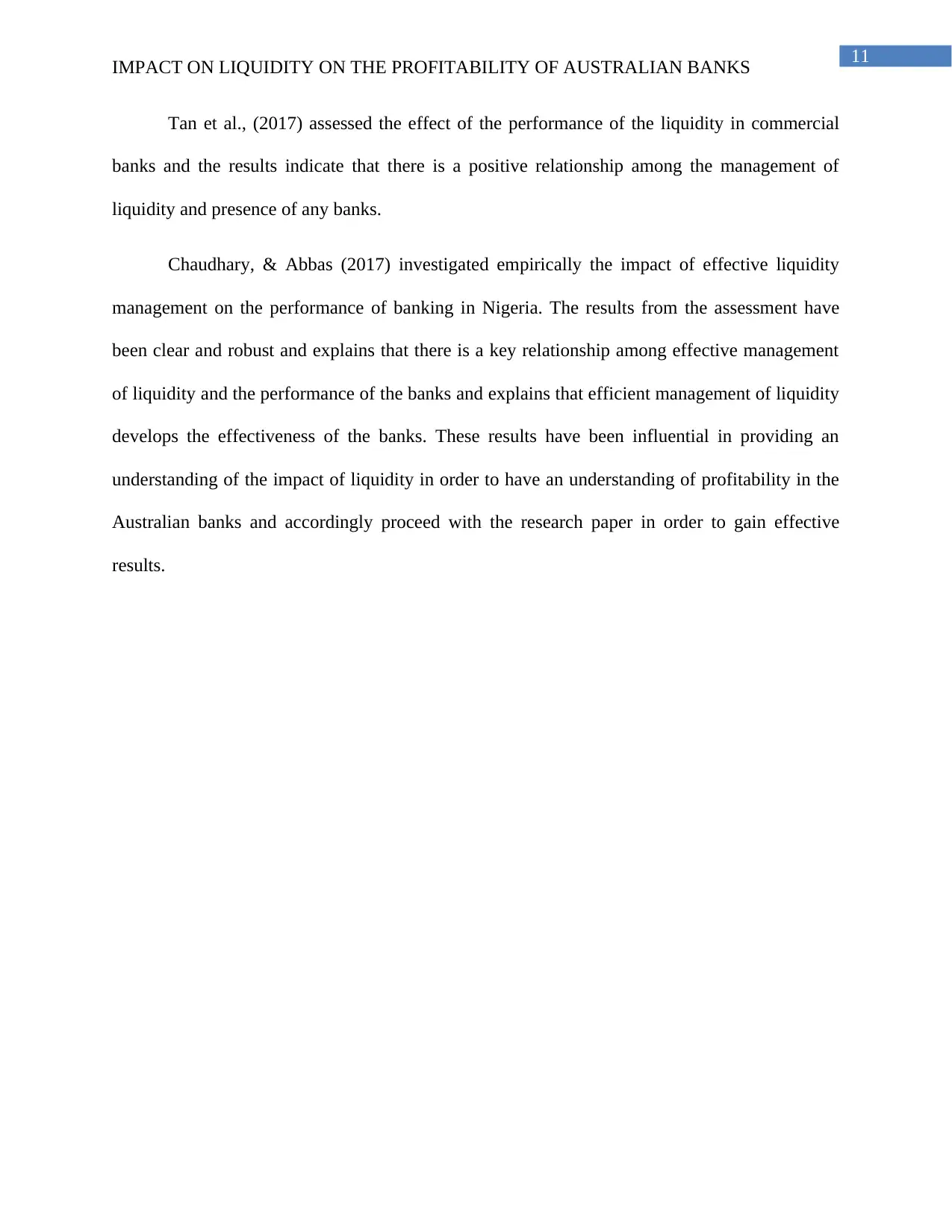
11
IMPACT ON LIQUIDITY ON THE PROFITABILITY OF AUSTRALIAN BANKS
Tan et al., (2017) assessed the effect of the performance of the liquidity in commercial
banks and the results indicate that there is a positive relationship among the management of
liquidity and presence of any banks.
Chaudhary, & Abbas (2017) investigated empirically the impact of effective liquidity
management on the performance of banking in Nigeria. The results from the assessment have
been clear and robust and explains that there is a key relationship among effective management
of liquidity and the performance of the banks and explains that efficient management of liquidity
develops the effectiveness of the banks. These results have been influential in providing an
understanding of the impact of liquidity in order to have an understanding of profitability in the
Australian banks and accordingly proceed with the research paper in order to gain effective
results.
IMPACT ON LIQUIDITY ON THE PROFITABILITY OF AUSTRALIAN BANKS
Tan et al., (2017) assessed the effect of the performance of the liquidity in commercial
banks and the results indicate that there is a positive relationship among the management of
liquidity and presence of any banks.
Chaudhary, & Abbas (2017) investigated empirically the impact of effective liquidity
management on the performance of banking in Nigeria. The results from the assessment have
been clear and robust and explains that there is a key relationship among effective management
of liquidity and the performance of the banks and explains that efficient management of liquidity
develops the effectiveness of the banks. These results have been influential in providing an
understanding of the impact of liquidity in order to have an understanding of profitability in the
Australian banks and accordingly proceed with the research paper in order to gain effective
results.
⊘ This is a preview!⊘
Do you want full access?
Subscribe today to unlock all pages.

Trusted by 1+ million students worldwide
1 out of 25
Related Documents
Your All-in-One AI-Powered Toolkit for Academic Success.
+13062052269
info@desklib.com
Available 24*7 on WhatsApp / Email
![[object Object]](/_next/static/media/star-bottom.7253800d.svg)
Unlock your academic potential
Copyright © 2020–2025 A2Z Services. All Rights Reserved. Developed and managed by ZUCOL.





